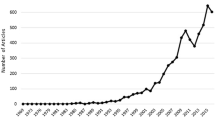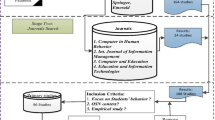Abstract
How do social aspects influence knowledge transfer in dynamic attributed networks? We address this issue by characterizing the behavior of the actors and their dynamic interactions based on the strategic positioning in a social structure. For this, we propose a method to characterize the behavior of nodes and their dynamic relationships based on temporal node attributes that capture how knowledge is transferred across a network. In order to assess our method, we apply it to unveil the differences of social relationships in distinct academic social networks and Q&A communities. We also validate our social definitions considering the importance of the nodes and edges in a social structure by means of network properties, as well as investigate the robustness of our method by stressing it for dealing with the time existence of the nodes in a network and the randomness of attributes associated with them. Moreover, we propose an unsupervised method to measure the academic importance of researchers based on our knowledge-transfer model, which outperforms traditional network metrics and other social-based approaches.





Similar content being viewed by others
Notes
Note that the sets \((\varGamma _1(u), \varGamma _{1+k}(u), \ldots , \varGamma _t(u))\) are dynamically built according to the degree of persistence, i.e., different instants k may contain completely distinct sets of relevant attributes.
Association for Computing Machinery: http://www.acm.org/sigs.
Data collected from DBLP (https://dblp.uni-trier.de) in June, 2018.
Stack Exchange: https://stackexchange.com, data collected in September, 2018.
We tested other values, but the results and conclusions are similar to the ones reported in this work.
Here, we omit the comparative results of our method with those of the RECAST social classification strategy (Vaz de Melo et al. 2015) and of our previously proposed social-based method (Silva et al. 2018), which were discussed by Silva et al. (2019). Overall, although based on different social perspectives, they are coherent regarding the edges’ strength.
As the distribution values per class did not pass the normality test, we evaluated the statistical significance between each two classes by means of the nonparametric Mann–Whitney–Wilcoxon test and among all classes by means of its extension given by the Kruskal–Wallis test (Hollander et al. 2013). All experiments were performed with a significance level of \(\alpha = 0.05\).
In our previous work (Silva et al. 2019), we analyzed the betweenness centrality distributions for RECAST (Vaz de Melo et al. 2015) and our social-based method (Silva et al. 2018). In summary, we highlighted that RECAST fails to separate social from casual relationships, and although our social-based method showed some coherence between its social definition and the network properties, it does not statistically distinguish its classes as bridges.
We also tested an alternative formulation for Eq. 1 that considered the closure expressed by means of the clustering coefficient centrality and the brokerage expressed by the betweenness centrality, but it achieved inferior results.
References
Bagrow JP, Danforth CM, Mitchell L (2017) Which friends are more popular than you? Contact strength and the friendship paradox in social networks. In: Proceedings of the 2017 In: IEEE/ACM international conference on advances in social networks analysis and mining, Sydney, Australia, pp 103–108
Barabási AL, Jeong H, Néda Z, Ravasz E, Schubert A, Vicsek T (2002) Evolution of the social network of scientific collaborations. Phys A Stat Mech Appl 311(3–4):590–614
Brandão MA, Vaz de Melo PO, Moro MM (2018) STACY: strength of ties automatic-classifier over the years. J Inf Data Manag 9(1):52–68
Burt RS (2005) Brokerage and closure: an introduction to social capital. Oxford University Press, Oxford
Chen Y, Liu J (2019) Becoming gatekeepers together with allies: collaborative brokerage over social networks. pp 81–88
Gilbert E, Karahalios K (2009) Predicting tie strength with social media. In: Proceedings of the SIGCHI conference on human factors in computing systems, Boston, MA, USA, pp 211–220
Granovetter MS (1973) The Strength of Weak Ties 78(6):1360–1380
Gupte M, Shankar P, Li J, Muthukrishnan S, Iftode L (2011) Finding hierarchy in directed online social networks. In: Proceedings of the 20th international conference on World Wide Web, Hyderabad, India, pp 557–566
Hollander M, Wolfe DA, Chicken E (2013) Nonparametric Statistical Methods, vol 751. Wiley, Hoboken
Huang H, Dong Y, Tang J, Yang H, Chawla NV, Fu X (2018) Will triadic closure strengthen ties in social networks? ACM Trans Knowl Discov Data 12(3):30
Inkpen AC, Tsang EW (2005) Social capital, networks, and knowledge transfer. Acad Manag Rev 30(1):146–165
Järvelin K, Kekäläinen J (2002) Cumulated gain-based evaluation of IR techniques. ACM Trans Inf Syst 20(4):422–446
Korkmaz G, Kuhlman CJ, Goldstein J, Redondo FV (2018) A model of homophily, common knowledge and collective action through Facebook. In: Proceedings of the IEEE/ACM international conference on advances in social networks analysis and mining, Barcelona, Spain, pp 409–412
Leskovec J, Huttenlocher D, Kleinberg J (2010) Predicting positive and negative links in online social networks. In: Proceedings of the 19th international conference on World Wide Web, Raleigh, North Carolina, USA, pp 641–650
Lima H, Silva TH, Moro MM, Santos RL, Meira Jr W, Laender AH (2013) Aggregating productivity indices for ranking researchers across multiple areas. In: Proceedings of the 13th ACM/IEEE-CS joint conference on digital libraries, Indianapolis, IN, USA, pp 97–106
Lü L, Zhang YC, Yeung CH, Zhou T (2011) Leaders in social networks, the delicious case. PloS One 6(6):e21202
Lü L, Zhou T, Zhang QM, Stanley HE (2016) The H-index of a network node and its relation to degree and coreness. Nat Commun 7:10168
Mahyar H, Hasheminezhad R, Ghalebi E, Nazemian A, Grosu R, Movaghar A, Rabiee HR (2018) Identifying central nodes for information flow in social networks using compressive sensing. Soc Netw Anal Min 8(1):33:1–33:24
Neshati M, Fallahnejad Z, Beigy H (2017) On dynamicity of expert finding in community question answering. Inf Process Manag 53(5):1026–1042
Newman ME (2004) Who is the best connected scientist? a study of scientific coauthorship networks. In: Complex networks, Springer, New York, pp 337–370
Orman GK, Labatut V, Plantevit M, Boulicaut JF (2014) A method for characterizing communities in dynamic attributed complex networks. In: Proceedings of the IEEE/ACM international conference on advances in social networks analysis and mining, Beijing, China, pp 481–484
Page L, Brin S, Motwani R, Winograd T (1999) The PageRank citation ranking: bringing order to the web. Technical report, Stanford InfoLab
Paranjape A, Benson AR, Leskovec J (2017) Motifs in temporal networks. In: Proceedings of the tenth ACM international conference on web search and data mining, Cambridge, UK, pp 601–610
Rezaei A, Perozzi B, Akoglu L (2017) Ties that bind: characterizing classes by attributes and social ties. In: Proceedings of the 26th international conference on World Wide Web (Companion Volume), Perth, Australia, pp 973–981
Sarkar S, Guo R, Shakarian P (2019) Using network motifs to characterize temporal network evolution leading to diffusion inhibition. Soc Netw Anal Min 9(1):14:1–14:24
Silva THP, Laender AHF, Vaz de Melo POS (2018) Social-based classification of multiple interactions in dynamic attributed networks. In: Proceedings of the IEEE international conference on big data, Seattle, WA, USA, pp 4056–4065
Silva THP, Laender AHF, Vaz de Melo POS (2019) Characterizing knowledge-transfer relationships in dynamic attributed networks. In: Proceedings of the IEEE/ACM international conference on advances in social networks analysis and mining, Vancouver, Canada, pp 234–241
Srinivas A, Velusamy RL (2015) Identification of influential nodes from social networks based on Enhanced Degree Centrality Measure. In: Proceedings of the IEEE international advance computing conference, Bangalore, India, pp 1179–1184
Srivastava S, Chaturvedi S, Mitchell T (2016) Inferring interpersonal relations in narrative summaries. In: Proceedings of the thirtieth AAAI conference on artificial intelligence, Phoenix, Arizona
Sun X, Kaur J, Milojević S, Flammini A, Menczer F (2013) Social dynamics of science. Sci Rep 3:1069
Tixier AJP, Rossi MEG, Malliaros FD, Read J, Vazirgiannis M (2019) Perturb and combine to identify influential spreaders in real-world networks. In: Proceedings of the IEEE/ACM international conference on advances in social networks analysis and mining, Vancouver, Canada, pp 73–80
Vaz de Melo POS, Viana AC, Fiore M, Jaffrès-Runser K, Mouël FL, Loureiro AAF, Addepalli L, Chen G (2015) RECAST: telling apart social and random relationships in dynamic networks. Perform Eval 87:19–36
Yo T, Sasahara K (2017) Inference of personal attributes from Tweets using machine learning. In: Proceedings of the IEEE international conference on big data, Boston, MA, USA, pp 3168–3174
Zhang G, Liu L, Wei F (2019) Key nodes mining in the inventor-author knowledge diffusion network. Scientometrics 118(3):721–735
Acknowledgements
This work is supported by project MASWeb (FAPEMIG grant APQ-01400-14) and by the authors’ individual grants from CAPES and CNPq.
Author information
Authors and Affiliations
Corresponding author
Additional information
Publisher's Note
Springer Nature remains neutral with regard to jurisdictional claims in published maps and institutional affiliations.
Rights and permissions
About this article
Cite this article
Silva, T.H.P., Laender, A.H.F. & Vaz de Melo, P.O.S. On knowledge-transfer characterization in dynamic attributed networks. Soc. Netw. Anal. Min. 10, 47 (2020). https://doi.org/10.1007/s13278-020-00657-4
Received:
Accepted:
Published:
DOI: https://doi.org/10.1007/s13278-020-00657-4




